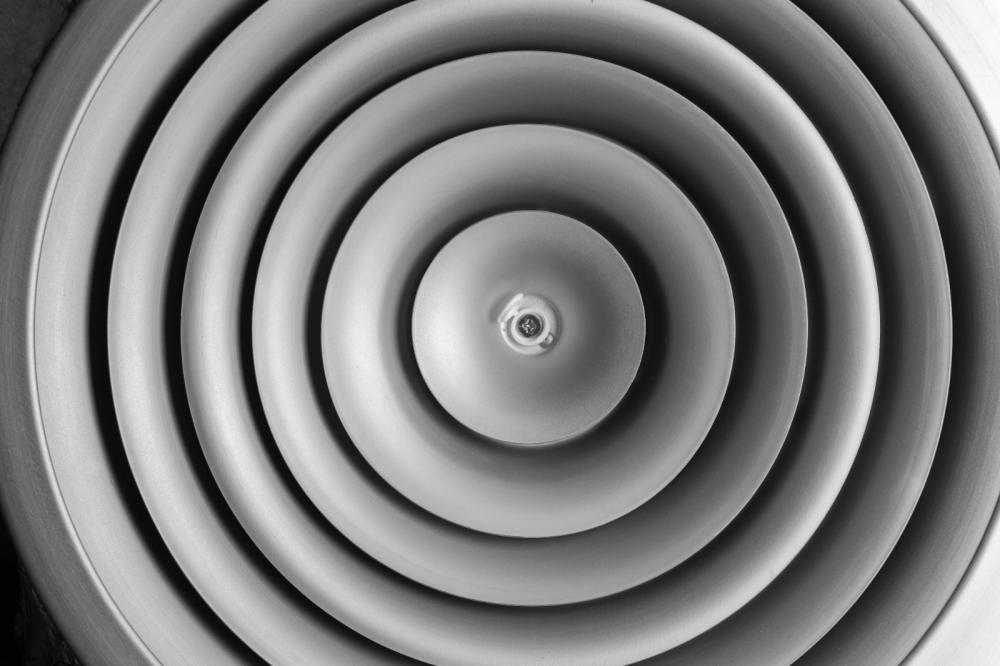
Overheating happens in buildings, when indoor temperatures, influenced by weather conditions, building design, insulation levels, and heating systems, rise excessively, making the living environment uncomfortably hot and potentially posing health risks to occupants.
One of the grand strategies of tackling the effect of climate change and creating a more sustainable future is building more energy efficient homes. This is the reason why modern buildings in the UK are designed as an insulated envelope with the motive of reducing heat loss which usually happens through the fabric of the building, especially in walls, roofs, doors, windows and floors.
Insulating a building serves the purpose of conserving the heat especially in winter, but in summer when the outside temperature is high and there is a cumulative rise in the internal temperature of the building, the risk of overheating increases.
Overheating is exacerbated in a building when there is no appropriate controlled ventilation to balance the heating effect of dwelling brought about by increased outside temperature which could be made pronounced when there are added internal heat gains from cooking, appliances and people.
Insulating and enveloping a building for air tightness, without mitigation through the installation of appropriate ventilation systems, can lead to extreme discomforts, fatigue, exhaustion, dehydration, lack of sleep and health issues like heat stroke or breathing conditions which affects the lungs.
By incorporating an appropriate method of cooling and ventilation of the home, we mitigate the heating impact on a building and improve comfortability and wellness of occupants.
Unlike commercial buildings which utilise different methods of cooling and ventilation methods , either as a central ventilation systems such as air handling units and fan coil units, or as individual units such as air-conditioning units, overheating are usually mitigated in homes through simpler methods, such as reduction of internal heat gains using various methods in homes, such as fixing energy efficient lights and equipments, using wooden shutter windows to reduce solar transmittance of heat, or by installing appropriate ventilation systems in the building which serves as a cross solution to the effect of overheating irrespective of the time of the year.
A combination of efficient insulation and appropriate ventilation, sustainable both in winter and in summer, is what is desirable in homes. This can be achieved without compromising on the reduction of energy costs and CO2 emissions.
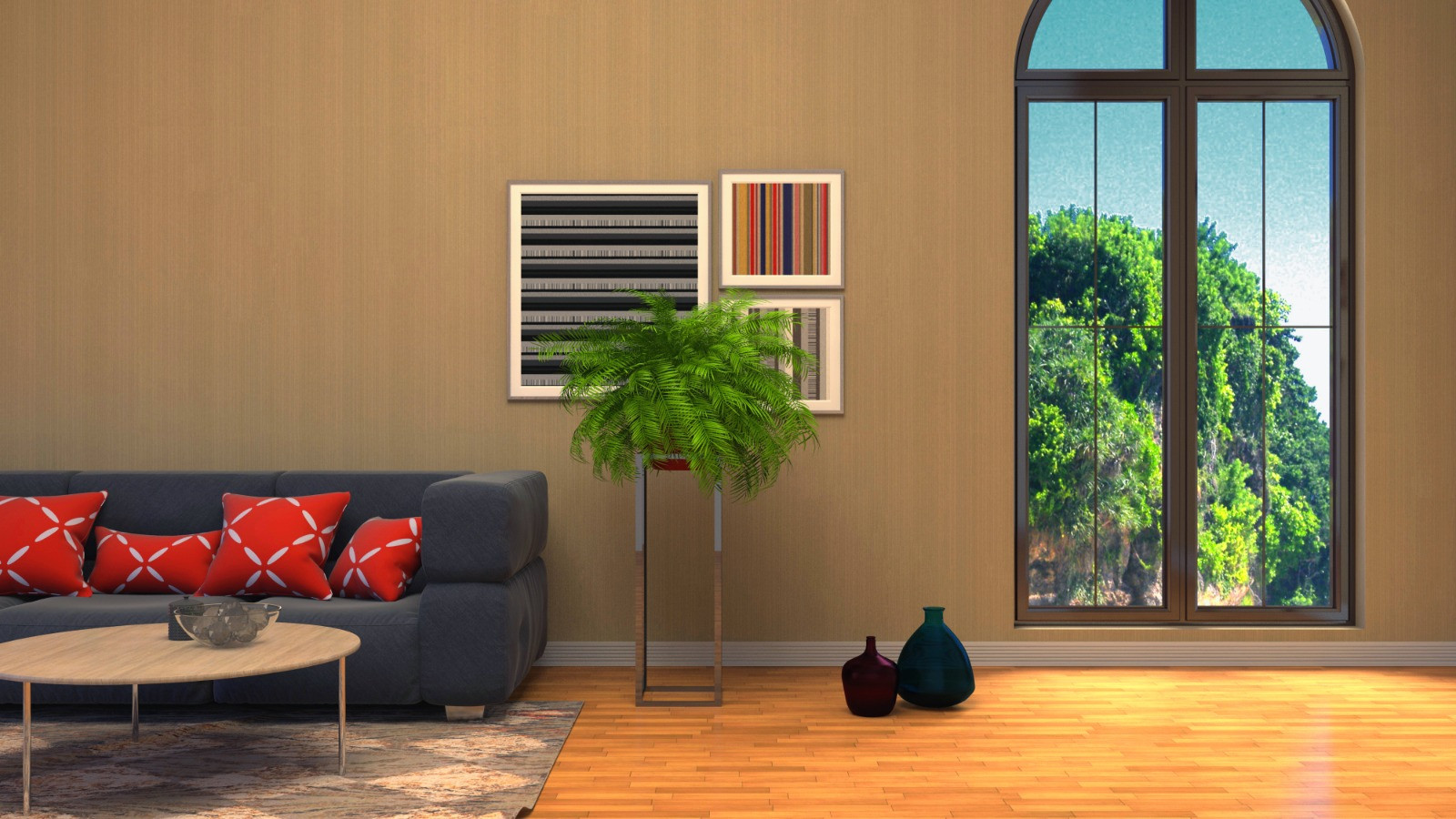
By having an adequate ventilation design in a well-insulated building, we can reduce or resolve the issue of overheating and improve the internal air quality and achieve a building sustainability.
This process when adequately carried out, serves as a means of eliminating condensation, damp and mould in the building, an essential prerequisite to the health and wellbeing of occupants, and also a guard of the structure against deterioration and structural damages.
Having quality air which is free from pollutants, virus, bacteria and any contamination that would affect the health and wellbeing of dwellers and the integrity of the dwelling is a desire for everyone, but how can this be best achieved?
The internal air quality of a building can be affected by such factors as the number of people in the dwelling and their lifestyles; contaminants such as moulds, fungi, industrial pollutants, traffic fumes, radon, moisture, methane, and the level of air infiltration into it, including the number of people in the dwelling, determines the quality of external air which could be a source of pollutant in the building.
To prevent overheating and to maintain a good internal quality of air, a whole building ventilation approach should be considered in the removal of pollutants and to supply fresh air in rooms.
To achieve this, ventilation mechanisms should be designed through a whole building ventilation approach to provide appropriate air quality measurements by a consideration of atmospheric factors such as the relative humidity and the level of carbon dioxide of a dwelling.
A whole building ventilation approach also includes a consideration on the choice of installation of such things like extract ventilations, trickle vents and purge vents in the building as a whole.
Some ventilation methods which can be adopted in homes are discussed below:
Passive stack systems are vertical ventilation units installed in strategic areas such as stairwells, shafts, or internal cores of buildings, to remove warm stale air from the building.
As indoor air warms up due to heating or solar gain, it becomes less dense and rises within the building. This buoyant warm air naturally seeks to escape through the vertical stacks, creating a pressure difference between the interior and exterior of the building.
 Passive stack systems incorporate inlet openings to facilitate airflow. These are usually located in lower parts of the building, which allow cooler outdoor air to enter the building and replace the warm air being expelled through the vertical stacks.
Passive stack systems incorporate inlet openings to facilitate airflow. These are usually located in lower parts of the building, which allow cooler outdoor air to enter the building and replace the warm air being expelled through the vertical stacks.
The system operates without any need for mechanical fans or pumps, by having air rise naturally through venturi effect of air movement across the roof and silently providing continuous extract.
Natural airflow is driven through pressure difference created by the buoyant warm air and the cooler outdoor air entering the inlet drives. This natural ventilation helps to remove stale air, excess moisture, and pollutants from the indoor environment, promoting better indoor air quality.
Passive stack ventilation systems are well-suited for low-rise residential buildings, office spaces, and other structures where natural ventilation can be effectively utilized to maintain indoor comfort and air quality.
They can, on the other hand be sensitive to poor installation which makes them not to work effectively and because they use ductworks, architectural design of buildings can make their installation or operations not as effective.
Intermittent extract fans are ventilation systems designed to turn on and off automatically based on humidity levels or occupancy, rather than running continuously.
The unit runs to remove stale air, moisture, and pollutants and can be installed in utility rooms, kitchens or bathrooms.
Many intermittent extract fans are equipped with sensors that detect humidity levels or motion which makes the fan automatically turn on to remove moisture or odours from the air.
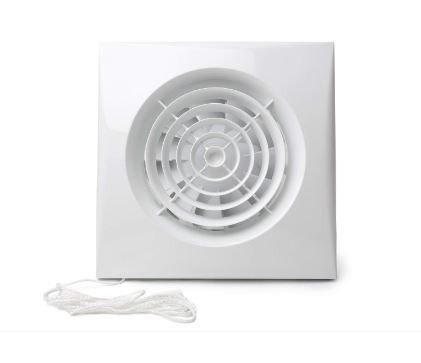
Some intermittent extract fans are controlled by timers, allowing users to set specific intervals for the fan to operate and often have manual override switches or controls that allow users to turn the fan on or off manually as needed.
They are usually cheap and easy to install and generally extract pollutants rapidly, but they can be noise driven. They have a typical life span of 6 years before replacement is due.
SRHRVs are ventilation systems which are designed to provide fresh air to a single room while simultaneously recovering heat from the stale air being expelled. They are commonly used in residential and commercial settings to improve indoor air quality and boost energy efficiency.
They work by exchanging indoor air with fresh outdoor air. Stale indoor air is continuously extracted from the room and passed through the ventilation unit, and as the stale indoor air passes through the SRHRV unit, it transfers its heat energy to a heat exchanger within the unit. At the same time, fresh outdoor air is drawn in and passes over the opposite side of the heat exchanger.
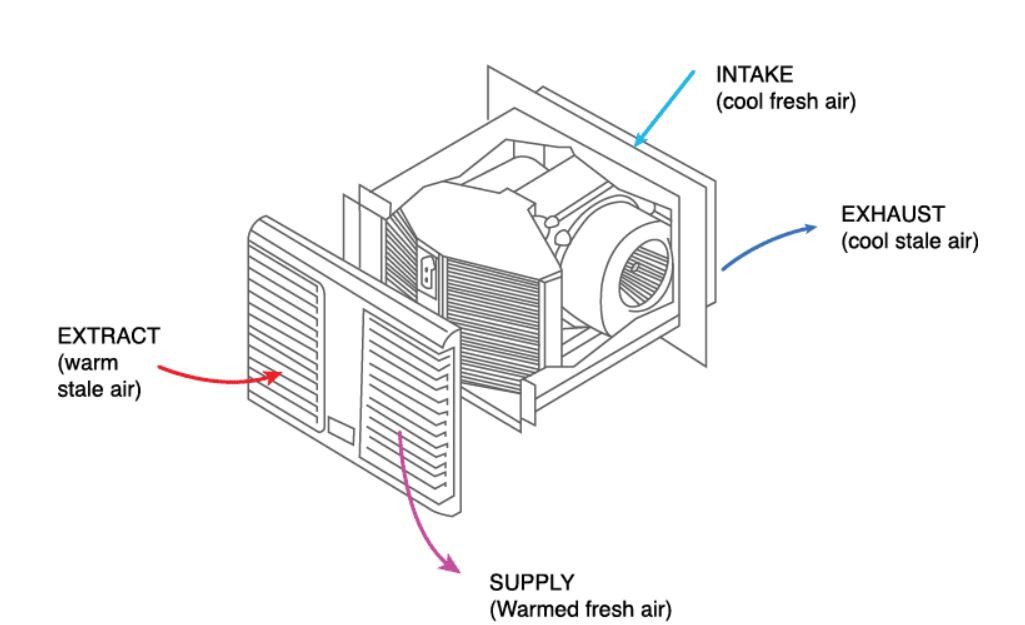
In the unit, the heat exchanger allows heat from the outgoing stale air to warm up the incoming fresh air without the two air streams mixing. This process helps to preheat the incoming air during colder months, thereby reducing the energy required to heat the room.
SRHRVs incorporate air filters to remove dust, pollen, and other airborne particles from the incoming fresh air. The units are also equipped with silent low energy fans which facilitate movement of air into and out of the unit.
SRHRVs are usually easy to install and operate in an efficient manner where heat is recovered from an exhaust air and can serve as alternatives, usually where mechanical ventilation system is difficult to be installed.
SRHRVs provide an effective energy-efficient solution for ventilating individual spaces while recovering heat and maintaining indoor air quality. They help reduce energy costs, minimize heat loss, and create a more comfortable and healthier indoor environment.
MeVs can be installed as a need to provide continuous ventilation and this can be centralised or decentralised. This means MeVs can ventilate the entire building or they can ventilate a specific room.
These systems typically consist of mechanical fans, ductwork, and sometimes heat recovery components. MEVs are commonly used in residential and commercial buildings to ensure adequate indoor air quality and comfort.
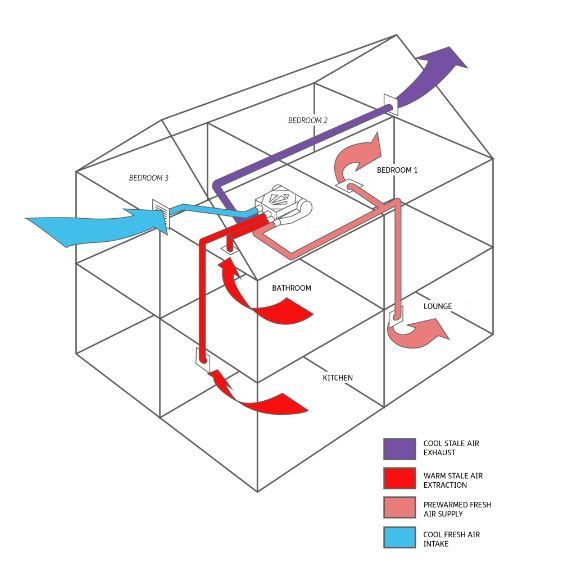
They have the benefit of providing continuous background air flow and they are easy to operate and provide a manual and automatic operation but the ductwork can be herculean to accommodate and they need added commissioning procedure to be put in place.
MEVs use mechanical fans to extract stale air from various sources within a building, such as bathrooms, kitchens, utility rooms, and other areas prone to moisture and pollutants. They consist of fans usually located strategically where stale air is present in order to transport this unwanted air through ductwork which are typically routed through walls, ceilings, or floors to the exterior of the building.
MEVs often incorporate controls or sensors to regulate airflow based on humidity levels, occupancy, or time of day. This allows for automatic adjustment of ventilation rates to meet changing indoor air quality needs while optimizing energy efficiency.
MVHR units has found its incorporation in many new builds to provide controlled air exchange while recovering heat from the outgoing stale air. MVHR systems are designed to improve indoor air quality and energy efficiency by continuously ventilating spaces while minimizing heat loss.
It consists of a heat recovery unit, which contains a heat exchanger that allows for the transfer of heat energy between the outgoing stale air being extracted and the incoming fresh air being supplied.
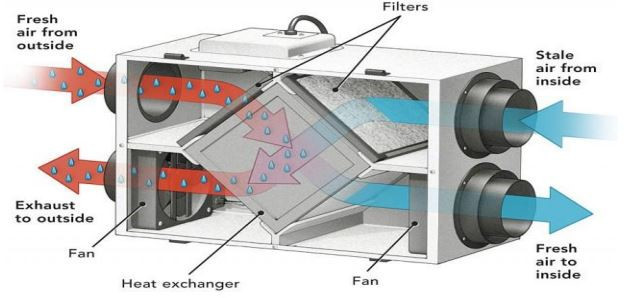
As stale indoor air is extracted from the building, it passes through one side of the heat exchanger in the MVHR unit. At the same time, fresh outdoor air is drawn into the unit and passes through the opposite side of the heat exchanger.
Heat is recovered from the extracted stale air and transferred to the fresh air supply without the two air streams mixing, pre-warming the fresh air in the process.
MVHR systems are equipped with low-energy fans which ensure a continuous flow of fresh air through the ductwork and the heat recovery unit into the building while simultaneously expelling stale air, maintaining indoor air quality and comfort.
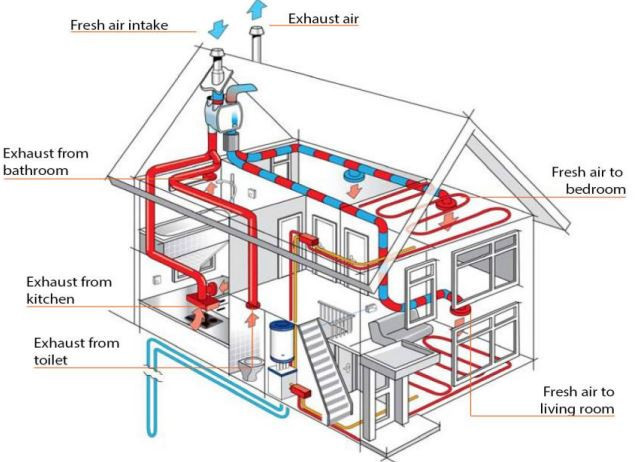
MVHR provides whole-house supply and extract ventilation within a sealed environment and without any added requirement for background ventilators. They are installed to allow for recirculation of heat in order to increase efficiency while improving the air quality, however the cost of installation, repairs and replacements can be high.
Conclusion
Addressing excessive overheating in homes is a multifaceted endeavor that requires a holistic approach encompassing various strategies and interventions. Through careful assessment, thoughtful design, and strategic implementation of measures such as shading, ventilation, thermal mass optimization, and efficient cooling systems, it is possible to mitigate overheating risks and enhance thermal comfort for occupants.
By fostering awareness, collaboration, and knowledge exchange between experts and homeowners, sustainable and resilient solutions tailored to the unique needs of each dwelling and mitigation against global warming can be achieved.
By prioritizing energy efficiency, climate resilience, and occupant well-being, we can create healthier, more comfortable living environments while contributing to a more sustainable built environment for future generations.